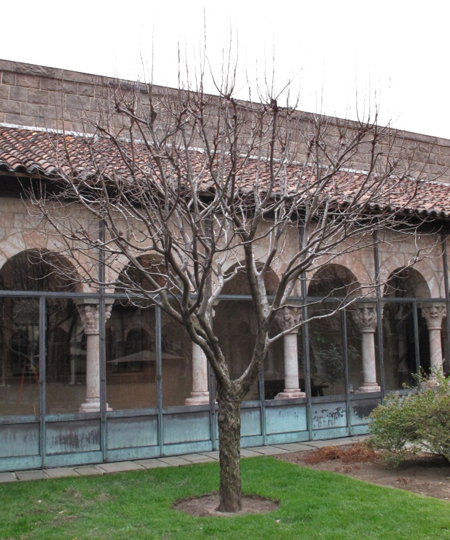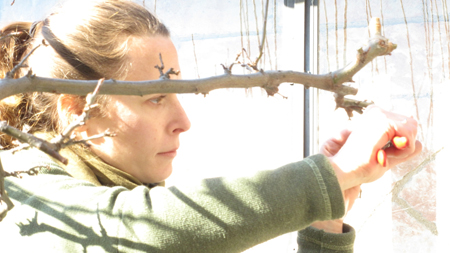The pruning of our fruit trees is undertaken in winter, when the trees are dormant. Above: One of four pollarded crab apples in need of pruning in Cuxa garden
The first important horticultural task of the New Year was the pruning of the crab apples in Cuxa cloister garth garden. (This year, the work was performed on Plough Monday, the traditional day on which farmers and workers returned to the fields after the Christmas rest. For a nineteenth-century account of the history of Plough Monday in English tradition, see Chambers’s Journal of popular literature, science and arts, Vol. 56.)
Above: Gardener Esme Webb cutting last spring’s growth. Below: The straight and rapid sucker growth engendered by last year’s??cuts is taken back to the??“heads” or??“knuckles” formed by three successive years of intensive pruning.??The crab apples have now been successfully??transformed into pollards.
Our consulting arborist, Fran Reidy, completed the three-year phased pruning necessary to transform??our crab apples into pollards last winter. The Gardens staff??is now undertaking the regular winter maintenance of the dormant trees, which entails taking the last spring’s growth back to the knuckle formed by previous cuts. Next spring’s buds will break from these knuckles, which are characteristic of pollarded trees. For more about our decision to pollard these trees with Fran’s help, see “Woodswoman, Pollard That Tree,” (February 25, 2011). For pollarding as a medieval woodland management technique, see “Coppicing and Pollarding,” (March 4, 2011). For more on the month of January and the return to work after the Christmas feast, see “Works and Days: The Medieval Year,” (January 9, 2009).
???Deirdre Larkin
Tags: crab apple, pollard




January 12, 2012 at 2:26 pm
OH! Thank you so much for taking care of that property! I just happened on this post and it brightened my day to think about The Cloisters. One of my favorite places in NYC, have to make it over there more.
PEACE
January 15, 2012 at 10:02 am
Deirdre
Elaine and I were there earlier this month with our three girls and relatives, two ecologists and their two daughters. We had a wonderful time. The girls noticed the pruning techniques in your blog. The cloisters seems unaffected by the passage of time, but we know it takes a lot to keep the gardens at their peak.
January 17, 2012 at 1:11 pm
When pollarding an apple tree, how do you ensure enough two year old growth to get flowers and fruit? Or does one rely on the fruiting spurs formed below the knuckles? I have always wondered!
January 26, 2012 at 7:08 pm
The fruiting spurs are just above and on the knuckles. As the trees grow older they will maintain their size through annual pruning. The annual rings will make the trees diameter increase as well as the knuckles. They look like large fists of old age defiance on ancient trees of Europe.
August 15, 2012 at 8:05 am
Generally I don’t learn article on blogs, however I would like to say that this write-up very pressured me to check out and do it! Your writing taste has been surprised me. Thank you, very great article.